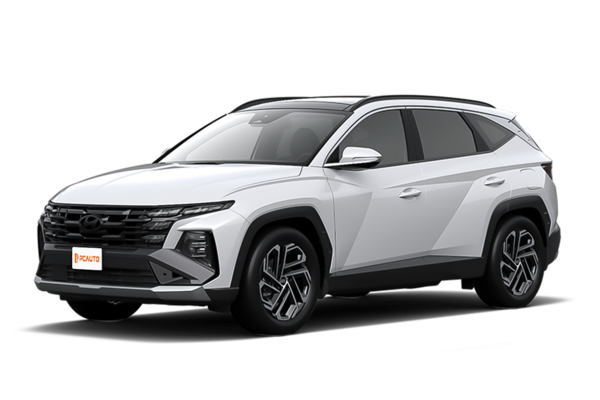Q
What is the difference between 2025 Tucson and 2024 Tucson?
The 2025 Tucson's key upgrades over the 2024 model focus on tech features and powertrain refinements. Exterior-wise, the '25 version might sport sharper LED lighting clusters and new sportier trim options. Inside, it gets a larger touchscreen with wireless Apple CarPlay/Android Auto, while select trims will offer digital key functionality.
Under the hood, the 2025 Tucson is expected to keep the 1.6T turbo and 2.0L naturally aspirated engines but with ECU tweaks for better fuel efficiency. The hybrid variant could receive higher-density battery packs.
Safety-wise, the '25 model will likely make smart cruise control and upgraded blind-spot monitoring standard—features typically reserved for higher trims in the 2024 lineup. Worth noting: Hyundai's ongoing "Sensuous Sportiness" design language means the 2025 iteration may have sleeker lines, paired with the latest connected services.
On resale value, outgoing models usually see a slight dip during generational transitions, but local market conditions play a big role. If you're cross-shopping, prioritize test drives—pay special attention to NVH levels and suspension tuning, as these make the most noticeable difference in daily driving.
Special Disclaimer: This content is published by users and does not represent the views or position of PCauto.
Related Q&A
Q
What transmission does 2025 Tucson have?
The 2025 Tucson models come with different transmissions. The 2025 Hyundai Tucson Style G2.0 MPi is equipped with a 6-speed AT (Automatic Transmission), which features mature technology and good shift smoothness, meeting the comfort needs of daily driving. The 2025 Hyundai Tucson Prime 1.6T-GDi and 2025 Hyundai Tucson Prestige 1.6T-GDi AWD are fitted with a 7-speed DCT (Dual-Clutch Transmission). The dual-clutch transmission offers fast shift speed and high transmission efficiency, with more direct power delivery, bringing drivers better driving pleasure and power response. The 2025 Hyundai Tucson Prestige 1.6T-GDi Hybrid is equipped with a 6-speed AT. When paired with the hybrid system, it enables more linear and stable power output, helping to enhance the vehicle's ride comfort and fuel economy.
Q
Where is the 2025 Hyundai Tucson made?
The 2025 Hyundai Tucson is primarily manufactured at Ulsan Plant in South Korea and Alabama Plant in the US, with some models for specific markets possibly sourced from the Czech plant in Europe. The exact production location depends on regional demand and logistics.
As a key player in Hyundai's global strategy, the Tucson rides on the third-generation platform (i-GMP), which enhances body rigidity and optimizes cabin space. It’s available in gasoline, hybrid, and plug-in hybrid variants to cater to diverse preferences. Local buyers might notice slight variations in features depending on the production origin—things like region-specific tuning for driver-assistance systems or infotainment setups—but core technologies and quality standards remain consistent worldwide.
Worth noting, the Tucson has gained traction in Southeast Asia thanks to its bold design and tech-packed offerings, with the hybrid version being a solid pick for fuel efficiency. Backing that up is Hyundai’s standard 5-year/unlimited-mileage warranty, giving owners extra peace of mind.
Q
Is the Hyundai Tucson 2025 a good car?
The 2025 Hyundai Tucson is a well-rounded SUV that ticks all the right boxes. Its exterior features the latest familial design language with a futuristic edge, while the cabin blends tech and practicality—think dual screens and smart connectivity that today’s buyers expect. Under the hood, it’ll likely carry over the current 1.6T turbo and hybrid options, striking a good balance between pep and efficiency for both city commutes and road trips. Safety-wise, the SmartSense suite packs adaptive cruise, lane-keeping assist, and more—nice peace of mind. Inside, rear legroom and cargo space are competitive for the segment, making it family-friendly. Locally, the Tucson’s got strong street cred with solid after-sales support, decent parts availability, and reasonable maintenance costs. Stacked up against Japanese or European rivals, it holds its own on value and kit. If you’re after tech and everyday usability, this one’s worth a test drive—swing by a dealer to see how it feels on the road before deciding.
Q
Does the 2025 Hyundai Tucson have memory seats?
The 2025 Hyundai Tucson does offer memory seat functionality on select higher trim levels. This feature typically comes bundled with power-adjustable seats and premium interior packages, allowing storage of multiple driver presets for seat position, mirror angles, and other personalized settings - particularly useful for households with multiple drivers sharing the vehicle.
Memory seat controls are usually located on the door panel or seat side with intuitive operation logic. When paired with power lumbar support, it noticeably enhances comfort on long drives. Worth noting: availability may vary across different Tucson configurations, so we'd recommend cross-checking the official specs or confirming with your dealer before purchase.
Within the segment, memory seats are more commonly found in mid-to-high trim Japanese and German SUVs like the Honda CR-V or Volkswagen Tiguan. Hyundai's competitive edge comes from offering this premium feature more readily across its range.
While it might seem like a simple convenience feature, memory seats actually require coordinated operation between seat motors, body control modules, and memory chips. Hyundai's recent advancements in electrical architecture have significantly improved both the reliability and response speed of these comfort-oriented systems.
Q
What's the cost of a 2025 Hyundai Tucson?
The 2025 Hyundai Tucson is available in multiple trim levels, with prices varying between different versions. Among them, the Hyundai Tucson Style G2.0 MPi is priced at RM 143,888; the Hyundai Tucson Prime 1.6T-GDi is sold at RM 164,888; the Hyundai Tucson Prestige 1.6T-GDi AWD is priced at RM 186,888; and the Hyundai Tucson Prestige 1.6T-GDi Hybrid is priced at RM 197,888. This price information can provide a budget reference for consumers who intend to purchase a car. Different trims differ in terms of configurations, power, etc. Consumers can choose the suitable trim based on their own needs and budget. For example, those in need of four-wheel drive can consider the Hyundai Tucson Prestige 1.6T-GDi AWD, and there are other more suitable options for those who value cost-effectiveness.
Q
Which country made Hyundai Tucson 2025?
The 2025 Hyundai Tucson is a global model designed and manufactured by Hyundai Motor Company, with production facilities strategically located across different regions—including its home base in South Korea, the Alabama plant in the U.S., and the Czech factory in Europe—to meet local market demands. Depending on regional preferences, specific trims may feature tailored configurations or alternate production sites.
Staying true to Hyundai’s signature design language, the Tucson packs advanced Smartstream engines, hybrid options, and the latest Hyundai SmartSense safety suite, delivering noticeable upgrades in tech and eco-friendliness. What’s worth noting? Hyundai’s global production network ensures consistent quality, while regional adaptations fine-tune the vehicle for climate and road conditions—think reinforced AC and cooling systems for tropical markets. Core engineering, from chassis tuning to powertrains, undergoes rigorous testing for reliability.
For potential buyers, checking official local channels is key to confirming region-specific specs and aftersales policies. With Hyundai’s well-established dealer and service network, you’ll get purchase options that actually fit your needs.
Q
What is the difference between 2025 and 2026 Hyundai Tucson?
As an automotive editor, here's my take:
Official details on the differences between the 2025 and 2026 Hyundai Tucson haven’t been released yet, but we can make some educated guesses based on typical model-year updates. The 2026 will likely see minor refinements over the 2025—think subtle exterior tweaks, upgraded interior materials, or enhanced infotainment features. Hyundai might also introduce more efficient hybrid tech or additional driver-assistance functions.
Under the hood, both years will probably keep the current 1.6T turbo and 2.0L naturally aspirated engine options, though the 2026 could squeeze out better fuel economy via ECU tuning. One safe bet? Hyundai’s recent focus on smarter tech means upgrades like wireless CarPlay, digital key integration, or an expanded Hyundai SmartSense safety suite are possible.
If you want the latest features, holding out for the 2026 might make sense. But if the 2025 offers solid discounts and meets your needs, it’s still a great buy. Your best move? Check the final specs at your local dealer and test-drive both to spot the real-world differences.
Q
What's new for 2025 Hyundai Tucson?
The 2025 Hyundai Tucson gets significant upgrades in design and technology, featuring sharper Parametric Dynamic styling with a more futuristic front grille and LED lighting clusters. Two new exterior colors join the palette as well.
Inside, it now comes standard with dual 10.25-inch digital displays (instrument cluster and touchscreen) and an upgraded ccNC infotainment system supporting wireless Apple CarPlay and Android Auto. Higher trims add a premium Bose sound system.
Powertrain options carry over the 1.6T gasoline and 2.0L diesel engines, but with retuned transmissions for better fuel efficiency. The hybrid variant sees improved electric-only range. Safety gets a boost with new Rear Cross-Traffic Collision-Avoidance Assist and digital key functionality, while Hyundai SmartSense (including lane-keeping and adaptive cruise) remains standard across the lineup.
Notably, the hybrid system now uses a more efficient lithium-ion battery with 15% faster charging than before—a tech trickle-down from its Kia cousins, showing Hyundai Motor Group's continued push into electrification. Other niceties include a panoramic sunroof and power liftgate.
Though it squares off against Japanese and European rivals in the compact SUV segment, the Tucson keeps its value edge with longer warranty coverage and localized service networks.
Q
Is the 2025 Tucson a good car?
The 2025 Tucson, positioned as a family-focused SUV, delivers solid performance in power, space, and tech features. Its 1.6T turbocharged or 2.0L naturally aspirated engines handle daily driving needs with ease, while the new hybrid option boosts fuel efficiency—perfect for practicality-minded buyers.
Inside, the cabin offers generous space, particularly for rear-seat legroom and cargo capacity, making it a standout in its class for family trips. Tech-wise, it comes equipped with the latest infotainment system supporting Apple CarPlay and Android Auto. Higher trims add perks like a panoramic sunroof, wireless charging, and advanced driver aids such as adaptive cruise control and lane-keeping assist, enhancing both convenience and safety.
Exterior styling stays true to Hyundai’s sharp, sporty design language, appealing to younger shoppers. Bottom line? The 2025 Tucson strikes a well-rounded balance for buyers seeking value, functionality, and modern flair. While top-tier versions cater to those prioritizing hybrid tech or smarter driving features, the base model already covers most everyday needs without compromise.
Q
What should I pay for a 2025 Hyundai Tucson?
**2025 Hyundai Tucson Pricing & Buying Guide**
The 2025 Hyundai Tucson is expected to be priced between RM140k to RM180k, depending on trim and powertrain choices. For example, the base 2.0L naturally aspirated engine and the high-spec 1.6T turbo hybrid could have a price gap of over RM30k. It’s best to check with authorized dealers for the latest quotes, as promotions like SST exemptions may affect final pricing.
This SUV stands out in its class with smart features, including a standard 10.25-inch digital cluster and smart cruise control. The hybrid version delivers impressive fuel efficiency at just 5.8L/100km, though opting for the HTRAC AWD system adds roughly RM15k. The recent facelift upgraded the Hyundai SmartSense suite, adding highway driving assist and remote smart parking.
Compared to Japanese rivals, the Tucson offers a stronger 5-year/unlimited-mileage warranty—just note its shorter 6-month/10,000km service intervals. Before buying, test-drive both engines: the 1.6T’s low-end torque is better for city driving, despite the higher price tag. Also, look out for dealer perks like free service packages.
Latest Q&A
Q
What transmission does 2025 Tucson have?
The 2025 Tucson models come with different transmissions. The 2025 Hyundai Tucson Style G2.0 MPi is equipped with a 6-speed AT (Automatic Transmission), which features mature technology and good shift smoothness, meeting the comfort needs of daily driving. The 2025 Hyundai Tucson Prime 1.6T-GDi and 2025 Hyundai Tucson Prestige 1.6T-GDi AWD are fitted with a 7-speed DCT (Dual-Clutch Transmission). The dual-clutch transmission offers fast shift speed and high transmission efficiency, with more direct power delivery, bringing drivers better driving pleasure and power response. The 2025 Hyundai Tucson Prestige 1.6T-GDi Hybrid is equipped with a 6-speed AT. When paired with the hybrid system, it enables more linear and stable power output, helping to enhance the vehicle's ride comfort and fuel economy.
Q
Where is the 2025 Hyundai Tucson made?
The 2025 Hyundai Tucson is primarily manufactured at Ulsan Plant in South Korea and Alabama Plant in the US, with some models for specific markets possibly sourced from the Czech plant in Europe. The exact production location depends on regional demand and logistics.
As a key player in Hyundai's global strategy, the Tucson rides on the third-generation platform (i-GMP), which enhances body rigidity and optimizes cabin space. It’s available in gasoline, hybrid, and plug-in hybrid variants to cater to diverse preferences. Local buyers might notice slight variations in features depending on the production origin—things like region-specific tuning for driver-assistance systems or infotainment setups—but core technologies and quality standards remain consistent worldwide.
Worth noting, the Tucson has gained traction in Southeast Asia thanks to its bold design and tech-packed offerings, with the hybrid version being a solid pick for fuel efficiency. Backing that up is Hyundai’s standard 5-year/unlimited-mileage warranty, giving owners extra peace of mind.
Q
Is the Hyundai Tucson 2025 a good car?
The 2025 Hyundai Tucson is a well-rounded SUV that ticks all the right boxes. Its exterior features the latest familial design language with a futuristic edge, while the cabin blends tech and practicality—think dual screens and smart connectivity that today’s buyers expect. Under the hood, it’ll likely carry over the current 1.6T turbo and hybrid options, striking a good balance between pep and efficiency for both city commutes and road trips. Safety-wise, the SmartSense suite packs adaptive cruise, lane-keeping assist, and more—nice peace of mind. Inside, rear legroom and cargo space are competitive for the segment, making it family-friendly. Locally, the Tucson’s got strong street cred with solid after-sales support, decent parts availability, and reasonable maintenance costs. Stacked up against Japanese or European rivals, it holds its own on value and kit. If you’re after tech and everyday usability, this one’s worth a test drive—swing by a dealer to see how it feels on the road before deciding.
Q
Does the 2025 Hyundai Tucson have memory seats?
The 2025 Hyundai Tucson does offer memory seat functionality on select higher trim levels. This feature typically comes bundled with power-adjustable seats and premium interior packages, allowing storage of multiple driver presets for seat position, mirror angles, and other personalized settings - particularly useful for households with multiple drivers sharing the vehicle.
Memory seat controls are usually located on the door panel or seat side with intuitive operation logic. When paired with power lumbar support, it noticeably enhances comfort on long drives. Worth noting: availability may vary across different Tucson configurations, so we'd recommend cross-checking the official specs or confirming with your dealer before purchase.
Within the segment, memory seats are more commonly found in mid-to-high trim Japanese and German SUVs like the Honda CR-V or Volkswagen Tiguan. Hyundai's competitive edge comes from offering this premium feature more readily across its range.
While it might seem like a simple convenience feature, memory seats actually require coordinated operation between seat motors, body control modules, and memory chips. Hyundai's recent advancements in electrical architecture have significantly improved both the reliability and response speed of these comfort-oriented systems.
Q
What's the cost of a 2025 Hyundai Tucson?
The 2025 Hyundai Tucson is available in multiple trim levels, with prices varying between different versions. Among them, the Hyundai Tucson Style G2.0 MPi is priced at RM 143,888; the Hyundai Tucson Prime 1.6T-GDi is sold at RM 164,888; the Hyundai Tucson Prestige 1.6T-GDi AWD is priced at RM 186,888; and the Hyundai Tucson Prestige 1.6T-GDi Hybrid is priced at RM 197,888. This price information can provide a budget reference for consumers who intend to purchase a car. Different trims differ in terms of configurations, power, etc. Consumers can choose the suitable trim based on their own needs and budget. For example, those in need of four-wheel drive can consider the Hyundai Tucson Prestige 1.6T-GDi AWD, and there are other more suitable options for those who value cost-effectiveness.
View MoreRelated News

Hyundai's Big Return to Malaysia: Top 5 Models Expected
MichaelMay 30, 2025

In Malaysia, which sliding door MPVs are available?
MichaelOct 30, 2025

Modern Ioniq 5 N Lands in Malaysia: Track-Level Performance Electric Vehicle is Here, Priced Possibly Below RM 400,000?
JohnSep 10, 2025

580,000 km & 87.7% Battery Health: Ioniq 5’s Incredible Durability
MichaelMay 6, 2025

Revolutionizing Hybrids: Hyundai’s New System vs. Toyota's Hybrid System
Kevin WongApr 22, 2025
View More













Pros
Cons